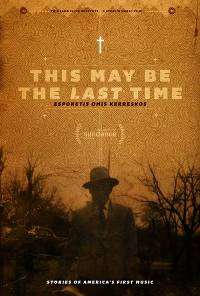This May Be the Last Time
| This May Be the Last Time | |
|---|---|
 Film poster | |
| Directed by | Sterlin Harjo |
| Produced by |
Sterlin Harjo Christina D. King Matt Leach |
| Music by | Ryan Beveridge |
| Cinematography |
Sterlin Harjo Shane Brown Matt Leach |
| Edited by | Matt Leach |
| Distributed by | Sundance Channel |
Release dates |
|
Running time | 90 minutes |
| Country | United States |
| Language |
English Mvskoke |
This May Be the Last Time is a 2014 American documentary film produced and directed by Sterlin Harjo.[1][2] The film had its world premiere at 2014 Sundance Film Festival on January 19, 2014.[3][4]
After its premiere at Sundance Film Festival, Sundance Channel acquired the distribution rights of the film. The film received its TV premiere in Spring 2014.[5][6]
Synopsis
The film narrates that when in 1962 Pete Harjo, the director's grandfather, mysteriously went missing after his car crashed on a rural bridge in Sasakwa, Oklahoma, members of his Seminole and Muscogee community searched for him while singing songs of faith and hope that had been passed on for generations, with roots in both Scottish hymn lining and African American music. Harjo interviews family members and locals, as well as academic experts on the subject including Yale professor Willie Ruff and Rogers State University's Hugh Foley.[7]
Reception
This May Be the Last Time received positive reviews from critics. Guy Lodge of Variety, said in his review that "Filtering painstaking research on the evolution of Creek Nation hymns through a tragic narrative from Harjo's family history, the director's first nonfiction feature is artful and illuminating."[8] Justin Lowe in his review for The Hollywood Reporter praised the film by saying that "The mystery of Pete Harjo’s disappearance turns out to be somewhat more prosaic, although Harjo plays out developments in the missing-person search skillfully enough to maintain interest, much in the storytelling tradition of his tribal elders."[9] Amanda Rock in her review for Slugmag said that "This film gives insight into a small community that supported each other through a difficult time, both physically and spiritually."[10]
References
- ↑ "American Indian music documentary "This May Be the Last Time" to premiere at Sundance Film Festival". Retrieved May 7, 2014.
- ↑ "#Cougsatsundance: 'This may be the last time'". Retrieved May 7, 2014.
- ↑ "Sundance 2014: Documentary Premieres". Retrieved May 7, 2014.
- ↑ "Sundance trailer of the day: 'This May Be the Last Time' [video]". Retrieved May 7, 2014.
- ↑ "Sundance: AMC/Sundance Channel Global Swoops on Six Sundance Titles". Retrieved May 7, 2014.
- ↑ "Film Review: 'This May Be the Last Time'". Retrieved May 7, 2014.
- ↑ Shannon, Susan (November 17, 2014). "Muscogee Creek Hymns Influenced By Congregational Line Singing?". KGOU. Retrieved 2015-10-09.
- ↑ "Film Review: 'This May Be the Last Time'". Retrieved May 7, 2014.
- ↑ "This May Be the Last Time: Sundance Review". Retrieved May 7, 2014.
- ↑ "SUNDANCE FILM REVIEW: THIS MAY BE THE LAST TIME". Retrieved May 7, 2014.
External links
- Official website
- This May Be the Last Time at the Internet Movie Database
- This May Be the Last Time at Rotten Tomatoes